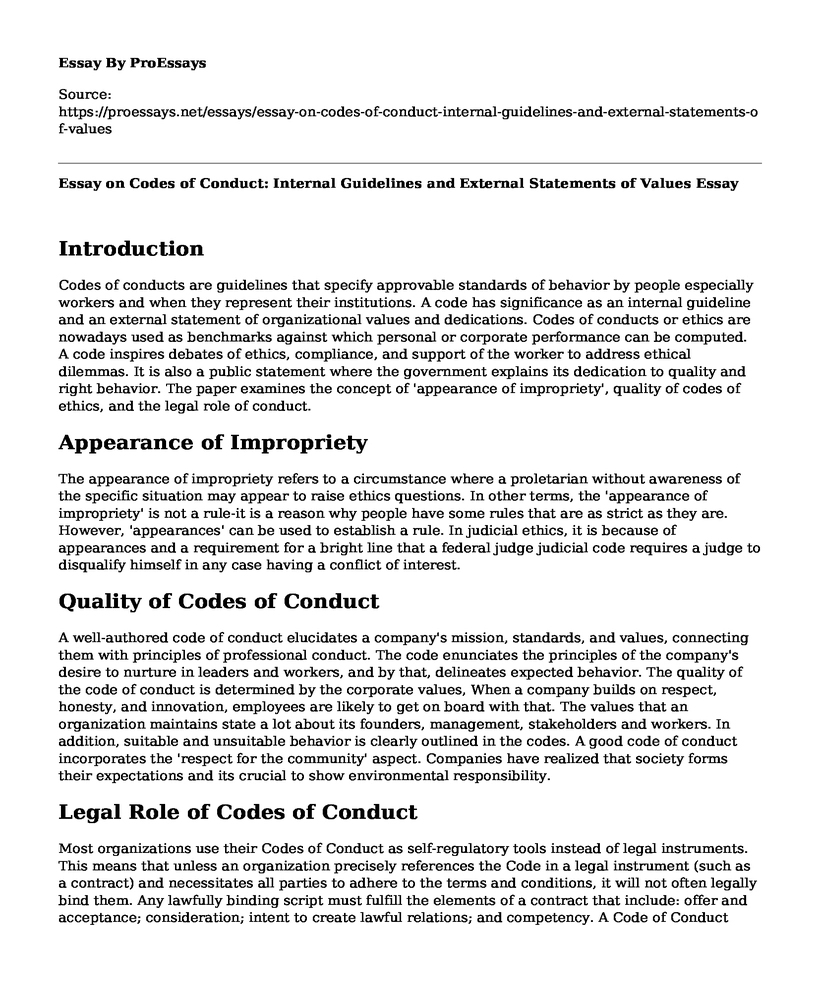Introduction
Codes of conducts are guidelines that specify approvable standards of behavior by people especially workers and when they represent their institutions. A code has significance as an internal guideline and an external statement of organizational values and dedications. Codes of conducts or ethics are nowadays used as benchmarks against which personal or corporate performance can be computed. A code inspires debates of ethics, compliance, and support of the worker to address ethical dilemmas. It is also a public statement where the government explains its dedication to quality and right behavior. The paper examines the concept of 'appearance of impropriety', quality of codes of ethics, and the legal role of conduct.
Appearance of Impropriety
The appearance of impropriety refers to a circumstance where a proletarian without awareness of the specific situation may appear to raise ethics questions. In other terms, the 'appearance of impropriety' is not a rule-it is a reason why people have some rules that are as strict as they are. However, 'appearances' can be used to establish a rule. In judicial ethics, it is because of appearances and a requirement for a bright line that a federal judge judicial code requires a judge to disqualify himself in any case having a conflict of interest.
Quality of Codes of Conduct
A well-authored code of conduct elucidates a company's mission, standards, and values, connecting them with principles of professional conduct. The code enunciates the principles of the company's desire to nurture in leaders and workers, and by that, delineates expected behavior. The quality of the code of conduct is determined by the corporate values, When a company builds on respect, honesty, and innovation, employees are likely to get on board with that. The values that an organization maintains state a lot about its founders, management, stakeholders and workers. In addition, suitable and unsuitable behavior is clearly outlined in the codes. A good code of conduct incorporates the 'respect for the community' aspect. Companies have realized that society forms their expectations and its crucial to show environmental responsibility.
Legal Role of Codes of Conduct
Most organizations use their Codes of Conduct as self-regulatory tools instead of legal instruments. This means that unless an organization precisely references the Code in a legal instrument (such as a contract) and necessitates all parties to adhere to the terms and conditions, it will not often legally bind them. Any lawfully binding script must fulfill the elements of a contract that include: offer and acceptance; consideration; intent to create lawful relations; and competency. A Code of Conduct cannot bind parties when there is no contract. Therefore, it may be legally binding when it fulfills the elements of a contract and it is established that an agreement was formed.
Conclusion
A quality code of conduct explains a company's values, mission, and principles, relating them to aspects of professional behavior. The code is crucial to the employees because it helps them in making daily decisions in their workplace. It is essential because it allows employees to handle ethical dilemmas and maintain the standards of the organization. However, some situations can raise ethics questions even when there is no insight into the circumstance. In that event, it is referred to as 'appearance of impropriety'. Many enterprises and legal fraternizes avoid the occurrence of this circumstance.
References
Kolb, R. W. (2008). Encyclopedia of business ethics and society. Thousand Oaks: Sage Publications.
Wendel, W. B. (2019). Professional responsibility. New York: Wolters Kluwer.
Cite this page
Essay on Codes of Conduct: Internal Guidelines and External Statements of Values. (2023, Feb 12). Retrieved from https://proessays.net/essays/essay-on-codes-of-conduct-internal-guidelines-and-external-statements-of-values
If you are the original author of this essay and no longer wish to have it published on the ProEssays website, please click below to request its removal:
- Organizational Change Paper Example
- Management Information Systems Essay
- Errors in the Problem-Solving Process Essay Example
- The Leader in Nelson Mandela Essay
- Paper Example on Attracting, Retaining, & Training Nurses in Rural Areas: An Evaluation
- SOLAS Chapter II-2 Fire Protection & Detection - Essay Sample
- Scientist Practitioner Model - Free Paper Sample







